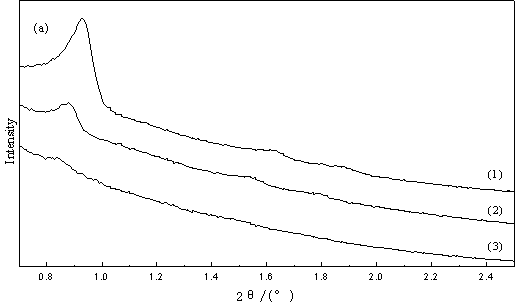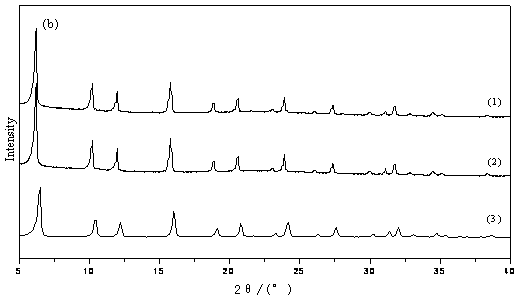Preparation method of mesoporous-microporous composite molecular sieve
A composite molecular sieve and microporous molecular sieve technology, which is applied in the field of preparation of mesoporous-microporous composite molecular sieves, can solve the problems of inconspicuous mesoporous structure of composite molecular sieves, channel blockage, channel collapse, etc., so as to improve hydrothermal and thermal stability. , The effect of improving the ratio of silicon to aluminum and high crystallinity
- Summary
- Abstract
- Description
- Claims
- Application Information
AI Technical Summary
Problems solved by technology
Method used
Image
Examples
Embodiment 1
[0027] Preparation of composite molecular sieve F-1:
[0028] (1) Add 200g tetraethyl orthosilicate to the HCl solution with a concentration of 0.28mol / L, and stir at 35°C for about 3 hours until it becomes a transparent solution;
[0029] (2) Dissolve 100g of diethanolamine in water, maintain the pH value at 3, and stir at 40°C for 2 hours to obtain a mixed solution containing cationic surfactant;
[0030] (3) Take 60g molecular sieve Y-1 (specific surface area 794 m 2 / g, pore volume 0.39 mL / g, average pore diameter 1.76nm, relative crystallinity 97%, acid content 0.632 mmol / g) was put into a hydrothermal furnace to react for 2 hours at 550°C and 2MPa pressure, and then taken out;
[0031] (4) Add the solution obtained in step (1) to the mixed solution obtained in step (2), stir at 40°C for 24 hours, then add 53g of molecular sieve Y-1 after hydrothermal treatment in step (3), and heat at 100°C Heat treatment in water for 48 hours, rinse the filter cake with a large amount...
Embodiment 2
[0033] Preparation of composite molecular sieve F-2:
[0034] (1) Add 200g tetraethyl orthosilicate to 0.28 mol / L HCl solution, stir at 35°C for about 3 hours until it becomes a transparent solution;
[0035] (2) Dissolve 50g of diethanolamine in water, maintain the pH value at 3, and stir at 40°C for 2 hours to obtain a mixed solution containing cationic surfactant;
[0036] (3) Take 150g molecular sieve Y-2 (specific surface area 759 m 2 / g, pore volume 0.37 mL / g, average pore diameter 1.85nm, relative crystallinity 96%, acid content 0.573 mmol / g) put into the hydrothermal furnace to react for 2 hours at 550℃ and 2MPa pressure, and then take it out;
[0037] (4) Add the solution obtained in step (1) to the mixed solution obtained in step (2), stir at 40°C for 24 hours, then add 107g of the molecular sieve Y-2 after hydrothermal treatment in step (3) and put it in water at 100°C Heat treatment for 48 hours, wash the filter cake with a large amount of deionized water until n...
Embodiment 3
[0039] Preparation of Composite Molecular Sieve F-3
[0040] (1) Add 200g tetraethyl orthosilicate to 0.30 mol / L nitric acid solution, stir at 35°C for about 3 hours until it becomes a transparent solution;
[0041] (2) Dissolve 50g of ethyleneimine in water, maintain the pH value at 3, and stir at 40°C for 2 hours to obtain a mixed solution containing cationic surfactant;
[0042] (3) Same as embodiment 1;
[0043] (4) Add the solution obtained in step (1) to the mixed solution obtained in step (2), stir at 40°C for 24 hours, then add 250g of the molecular sieve Y-1 after hydrothermal treatment in step (3) and put it in water at 100°C Heat treatment for 48 hours, wash the filter cake with a large amount of deionized water until neutral, dry at 120°C for 6 hours, and then bake at 550°C in an air atmosphere for 7 hours to remove surfactant molecules and obtain a microporous-mesoporous composite molecular sieve F-3, see Table 1 for the physical parameters of the composite mole...
PUM
 Login to View More
Login to View More Abstract
Description
Claims
Application Information
 Login to View More
Login to View More - R&D
- Intellectual Property
- Life Sciences
- Materials
- Tech Scout
- Unparalleled Data Quality
- Higher Quality Content
- 60% Fewer Hallucinations
Browse by: Latest US Patents, China's latest patents, Technical Efficacy Thesaurus, Application Domain, Technology Topic, Popular Technical Reports.
© 2025 PatSnap. All rights reserved.Legal|Privacy policy|Modern Slavery Act Transparency Statement|Sitemap|About US| Contact US: help@patsnap.com


